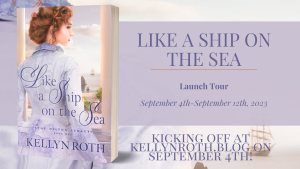
In today’s post, we’re going to talk about the Gilded Era in America because I think it’s fascinating and because it’s the era I actually remember the most about from school. (Other than eras that happened wayyy before anything I’ve ever written.)
ANYWAYS, because Patrick actually works in an industry (have you noticed all my other American fellas have pretty basic, could-be-done-anywhere jobs? Not intentional, but that’s how it panned out) and has money … also, yeah, apparently the two things I associate with the Gilded Era are industry and money, which is fun.
Before that, here’s the normal launch tour stuff . . .
About Like a Ship on the Sea
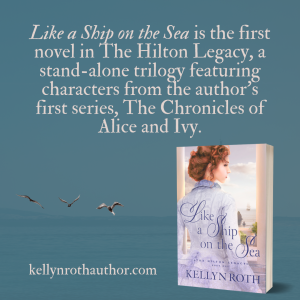 If God asks you to confront a storm, how dare you stay in the harbor?
If God asks you to confront a storm, how dare you stay in the harbor?
Lady Mary Cassidy O’Connell has a dream that can be summed up in three connecting ideas: a loving husband, adorable children, and a home of her own. Her mother’s lack of care makes life difficult for Cassie, and an escape is necessary. The plan? Marry Aubrey Montgomery, the man her parents have chosen for her, and find the peace she craves.
Unfortunately, Cassie is uneasy about marrying Aubrey. Her apprehension grows as she witnesses her dearest friend’s loving marriage take place. At this wedding, she catches the eye of Patrick Hilton, son of a wealthy American. Like Cassie, he’s also set to marry a woman chosen by his parents—only, Patrick claims, he is content with this choice.
Torn between her desire for happiness and the knowledge that God is leading her in a different direction, Cassie confronts the impossible decision. Is a loveless marriage of obligation better than being alone, or will she set sail on a voyage without a safe harbor?
Like a Ship on the Sea is the first novel in The Hilton Legacy, a stand-alone trilogy featuring characters from the author’s first series, The Chronicles of Alice and Ivy.
AMAZON ~ GOODREADS
About The Hilton Legacy

The Hilton Legacy will be a trilogy (with perhaps one standalone spin-off, depending on how I decide to do this!) set in 1880s and 1890s America and Europe.
The first novel, Like a Ship on the Sea, which is the one we’re celebrating today, features Patrick Hilton and his eventual love interest, Cassie. Of course, we know all about this novel!
The second novel, Like the Air After Rain, will feature Lorelei Hilton and her love interest and will primarily take place in England. There’s going to be a marriage of convenience angle that will be a lot of fun, methinks!
The second novel, Like Lightning in a Bottle, will feature Gwendolyn Hilton and her love interest and will primarily take place in England and America. This one is a little bit of a wild card, but we’re gonna have fun with it.
The Schedule
Monday, September 4th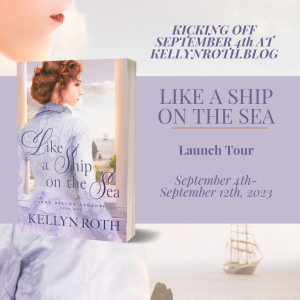
“Why You Should Read Like a Ship on the Sea” by Kellyn Roth
Book Spotlight by Abby Johansen
Author Interview by Naomi Sowell
Tuesday, September 5th (LAUNCH DAY!)
“All the Launch Day Celebrations” by Kellyn Roth
Wednesday, September 6th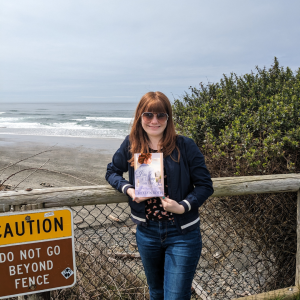
“About the Gilded Era” by Kellyn Roth
Thursday, September 7th
“Tackling Tough Topics with Tact” by Kellyn Roth
Friday, September 8th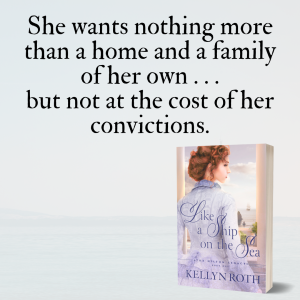
“A Guest Post by Alice Strauss” by Kellyn Roth
Book Spotlight by M.C. Kennedy
Book Spotlight by Bizwings Book Blog
Saturday, September 9th
“Introducing the Hiltons of Boston” by Kellyn Roth
Monday, September 11th
“How The Hilton Legacy Fits in with The Chronicles of Alice & Ivy” by Kellyn Roth
Author Interview by Amy Ullrich
Review by Pens, Pages, and Pulses
Author Interview by Jane Mouttet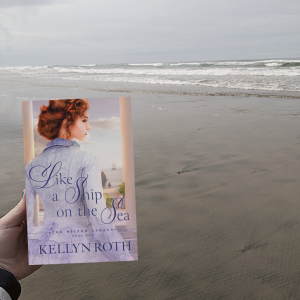
Book Spotlight by Rhys-Marie Whitnell
Tuesday, September 12th
“All About Book Two, Like the Air After Rain” by Kellyn Roth
Book Spotlight by Grace A. Johnson
Interview & Review by Saraina Whitney
The Giveaway
 Don’t forget to enter the giveaway! There will be a USA and International Winner, so even if you don’t live in my country, ENTER ANYWAY, because I made a prize just for you!
Don’t forget to enter the giveaway! There will be a USA and International Winner, so even if you don’t live in my country, ENTER ANYWAY, because I made a prize just for you!
US-Only Giveaway: a signed paperback copy of Like a Ship on the Sea, a themed candle, two bookmarks, three character art prints, a themed charm bracelet, and extra special bonus scenes.
International Giveaway: an ebook copy of Like a Ship on the Sea, extra special bonus scenes, a themed phone wallpaper, and the first chapter of book 2.
ENTER NOW!
Or paste this link into your browser: http://www.rafflecopter.com/rafl/display/cbb544c921/
The Bookish Tag
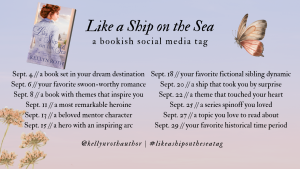
With the help of Grace A. Johnson (who is way too kind to me), I am hosting a bookish tag! This can be done on any social media profile (or even your blog) and is a fun way to join together to celebrate the launch! Starting today!
I’m doing the prompt on my Instagram and Facebook profiles, and I may try to repost some of these to Twitter, too!
The Prompts
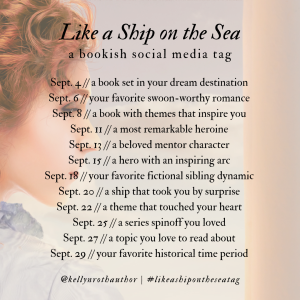 Sept. 4 // a book set in your dream destination
Sept. 4 // a book set in your dream destination
Sept. 6 // your favorite swoon-worthy romance
Sept. 8 // a book with themes that inspire you
Sept. 11 // a most remarkable heroine
Sept. 13 // a beloved mentor character
Sept. 15 // a hero with an inspiring arc
Sept. 18 // your favorite fictional sibling dynamic
Sept. 20 // a ship that took you by surprise
Sept. 22 // a theme that touched your heart
Sept. 25 // a series spinoff you loved
Sept. 27 // a topic you love to read about
Sept. 29 // your favorite historical time period
Rules
- There are prompts for every other weekday in September, but you’re welcome to share whenever you can and catch up at any time.
- Feel free to use any social media, including Instagram, Facebook, Twitter, your blog, and Youtube.
- Share about books that fit into the categories, and have fun!
- Don’t forget to use the hashtag #likeashipontheseatag and tag Kellyn (@kellynrothauthor on Instagram & Facebook or @kellyntheauthor on Twitter) to be shared!
About the “Gilded Era”
Technically the term is actually “Gilded Age,” but I find it easier to differentiate it as an era, so … well, I’ll refer to it as an age from now on. But I already made the title graphic, so meh.
The term “Gilded Age” was coined by Mark Twain in his book “The Gilded Age: A Tale of Today,” which he co-wrote with Charles Dudley Warner and published in 1873. Twain used the term to describe the period in American history from the 1870s to the early 1900s, and it reflected his satirical view of the era.
The word “gilded” suggests something that appears shiny and golden on the outside but is actually made of inferior materials beneath the surface. Twain used this metaphor to critique the wealth and opulence of the time, which often masked deeper social problems and inequalities.
While some people were amassing enormous fortunes and living lavishly, many others were struggling in poverty and facing harsh working conditions. And, well, that kind of sucks. But it sure gives us a lot of story fodder!
In essence, the Gilded Age was characterized by a stark contrast between the outward appearance of prosperity and the underlying social issues and disparities. It’s a term that has endured in historical discussions to describe this complex and contradictory period in American history.
Picture this: America, late 19th century. The Industrial Revolution was humming along like a well-oiled machine, and fortunes were being made faster than you could say, “I’ll take the private railroad car, please.” This was the Gilded Age, a time of excess, extravagance, and opulence that would make even today’s billionaires do a double-take.
Now, let’s talk social changes.
High society was the place to see and be seen. The Astors, the Vanderbilts, and the Rockefellers were the influencers of their day, and they threw parties that put modern-day galas to shame. If you weren’t invited to a soirée at the Vanderbilt mansion, well, you might as well have been living in a coal mine. *GASP*
But beneath all that glitz and glamour, social unrest was brewing. The wealth gap was wider than ever, and while some were sipping champagne in their ivory towers, others were working 12-hour days in dangerous factories. Labor strikes and protests became more common than spotting a peacock at a Vanderbilt garden party (because for some reason, that was a thing … actually, who am I kidding, I would totally own peacocks if I could).
While the upper crust was living it up, the Gilded Era was also a time of incredible innovation. Thomas Edison gave us the light bulb, Alexander Graham Bell brought us the telephone, and the Wright brothers were building contraptions that would soon become airplanes. It was like a mad scientist’s dream come true.
But let’s not forget the … um … quirky side of progress. This was the era of bizarre inventions like the “electric corset,” designed to shock women into a more svelte figure. Oh, and let’s not forget the bicycle craze that swept the nation, leading to a fashion trend that can only be described as “bloomers gone wild.”
Politics in the Gilded Age were a wild ride. Corruption ran rampant, and one name that stands out is Boss Tweed, the Tammany Hall leader who made the phrase “Tammany tiger” synonymous with political graft. He even had a famous cartoonist, Thomas Nast, on his tail, exposing his shady dealings through satirical illustrations. (Though this isn’t something that Patrick would’ve been familiar with, you can tell he’s already somewhat … disillusioned … with America. And I can’t say I blame him.)
Honestly, a lot of this makes it sound like a modern reality TV show to me, which is why I love it. It’s silly. It’s preposterous. You can just feel this being the backstory of shows set in the Edwardian era (directly after this). Cora Crawley (formerly Levinson) lived in this era, after all … and that’s when she caught her English lord, much as Patrick jokes his sisters want to do!
The completion of the first transcontinental railroad in 1883 connected the east and west coasts of the United States, facilitating commerce and travel. Rail travel became more accessible to the general population as ticket prices dropped, making it a popular mode of transportation for both business and leisure travelers. (This is why I noted that Baldwin & Sons, as opposed to the Hilton Shipping Company, is takin’ names with transcontinental travel over purely ocean-based shipping. Patrick is right … you have to be open to adaptation to grow!)
But of course, trains still weren’t everything. Steamship travel also played a vital role in expanding travel options, especially for coastal and international journeys. Steam-powered ships made ocean travel more reliable and efficient. Steamship lines operated regular passenger services between major American ports and destinations in Europe, Asia, and Latin America. This meant that everyone (and everything) could really get everywhere … and much quicker than ever before!
In my story, I don’t dig very deeply into any one aspect, but I do like to add little details that, if you know some backstory, you can hopefully enjoy!

TTFN!
~Kell~
P.S.
What do you like about the Gilded Age? Dislike? Do you enjoy reading about the era or is it just a boring one to you?

Are you interested in getting to know me & my books better?
I want to invite you to my super secret club. I mean, it’s not really a secret, because I’m telling you about it now, but here goes.
Join Mrs. Roth’s Society Column, my street team! We’d love to have you along for the ride!


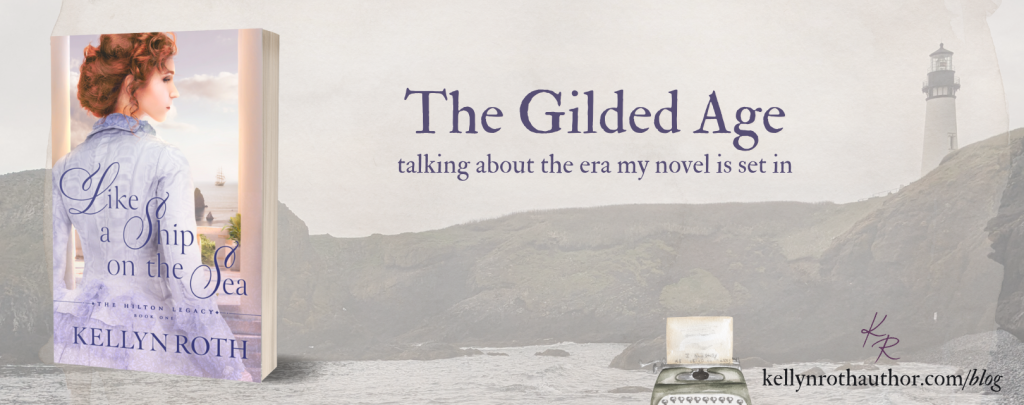
6 Responses
Love the cover.
Thank you so much!
Wow, the Gilded Era is so fascinating! (And I actually like the sound of that more than the Gilded Age XD)
Maybe it should be what we call it from now on. XD I’m happy to start a trend … and yes! It was pretty interesting!